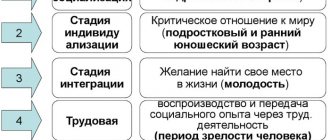Stages of conflict. Sociologists argue that conflict interaction is a normal state of society. After all, any society, regardless of era, is characterized by the presence of situations of confrontation. Even when interpersonal interaction is built harmoniously and is based on mutual understanding, clashes are inevitable. In order for confrontations not to destroy the life of society, for public interaction to be adequate, it is necessary to know the main stages of conflict development, which will help to identify the moment of emergence of confrontation and effectively smooth out sharp edges in disputes and disagreements. Most psychologists recommend using confrontation as a source of self-learning and life experience. Analysis of a conflict situation allows you to learn more about your own person, the subjects involved in the confrontation and the situation that provoked the confrontation.
Stages of conflict situations
Psychology in the development of conflicts identifies several stages with distinctive features. Familiarity with the stages of conflict development that accompany the escalation of disagreements and their characteristics will help to find ways to solve the problem. The stages of conflict development are supported by the participants unconsciously, without deviating from the standard scenario. Emotional manifestations and the outcome depend on the preparedness of the parties.
Latent stage
When there are prerequisites for the emergence of disagreements, they speak of the emergence of a conflict. There are factors whose presence provokes disputes. These include:
- Problems with the transfer of information when misunderstandings arise or facts are distorted;
- Environment. Constant pressure on a person with an authoritarian leadership style, lack of opportunity to express one’s own opinion, participation in work without enthusiasm, lack of motivation lead to various kinds of contradictions;
- Features of character, worldview. Conflict arises when people with different values and views on problems meet. Incorrect communication, rudeness, and disrespect for others also provoke the development of discontent.
These reasons are not a reason for the development of a conflict, but represent the ground on which a dispute can easily flare up if the factors are not eliminated. Then the warring parties move on to the next stages of the conflict, from which it is more difficult to get out. Pre-conflict in its development includes the stages of emergence and awareness of the problem, attempts to resolve it peacefully and the emergence of a pre-conflict situation.
Conflict
When two parties come into interaction wanting to prove they are right or express an opinion, the next main stage of the conflict begins, tension. It is communication that infringes on the interests of the participants that characterizes the stage.
Disagreements become obvious to everyone, including those around you. Active expression of emotions is the main sign of the stage. How the conflict will develop depends on the preparedness of the parties. Usually emotions come first, so logic and sanity recede into the background. One of the parties is trying to limit the actions of the other, to deprive it of an object that is an element of the structure of the conflict. Insults are used, designed to humiliate, offend, and provoke emotions. Violence, the purpose of which is to inflict physical pain, is not excluded.
The manifestation depends on the degree of tension of the opponents, their ability to maintain composure and look at things soberly.
Note! If the motive for the conflict is hidden behind other reasons, people do not understand the essence of what is happening. As a result, discussions will be protracted. It is important to be aware of the problem in order to sort out the positions of opponents and begin to resolve disagreements.
Tense stage of the conflict
Solution of a problem
The parties understand that they need to look for the right solutions to get out of the situation. Actions are aimed at ending the conflict. The literature describes the following stages of conflict resolution:
- Cooperation;
- Compromise;
- Violence;
- Confrontation;
- Avoiding conflict.
The use of these templates allows you to achieve different results when both parties or one of them benefit. In this case, the other may be left with nothing or suffer great losses. The ability to conduct dialogue and understanding the essence of the problem will help you get out of the situation without going through all the stages of the conflict dynamics and suffer the least losses.
Post-conflict stage
The confrontation ends, the parties sum up the results, determine whether their expectations were justified. If the participants were able to come to an agreement and get out of the conflict with dignity, then, in addition to benefits, they receive the preservation of the relationship. A benevolent ending puts people in a positive mood, and the post-conflict is perceived as a way to reach a compromise. When one side loses, the disagreement leaves an unpleasant aftertaste and the relationship is destroyed. This may be the emergence of a new conflict, since interaction and, accordingly, information exchange will be disrupted.
Important! If you distinguish the stages of a conflict and manage them based on common sense and not on emotions, its completion will be satisfactory for all participants. You need to be able to hear your opponent and competently argue your position.
Peaceful solution to the conflict
Conflict Prevention
Stages of relationships between a man and a woman - description of the main periods
To prevent conflict from developing, you need to remain calm. Emotions arise when reality does not meet expectations. You need to understand that people are not perfect, events do not always develop according to the planned pattern. It is important to control yourself, relying on reasonable arguments, and soberly assessing what is happening.
You need to try to take the side of the opposite side, look for common ground in order to identify a common goal. Working in one direction brings people together and makes confrontation pointless. It is important to treat your interlocutor with respect and not to get personal. Insults are unacceptable, especially if a person specifically seeks this, tries to bring the situation to a conflict. You always need to listen to the opposing opinion, evaluate its significance for yourself and your interlocutor, and voice your arguments. Conducting a discussion based on respect will help to come to a decision before emotional tension arises, then the tense stages of the conflict will bypass the discussion between the parties.
The ability to prevent conflicts before disputes escalate is an important skill. Already at school they begin to present information to children in the form of short courses of lectures. Students in grades 6-7 are introduced to the concept of interpersonal and group conflicts.
Conflict resolution
At what stage it is easiest to resolve a conflict depends on the participants and the goals they are pursuing. When interlocutors are ready to cooperate before violent disagreements begin, the problem can be resolved quickly and with maximum benefit. If there is a misunderstanding or lack of information, you need to bring the possible enemy to dialogue. Constructive communication will help you name the problem and resolve it peacefully. To do this, you need to understand the essence, find out the hidden motive of the conflict, if there is one.
Types of human memory in psychology, classification of main types
The interlocutor's disposition is a mandatory attribute to determine the cause of disagreements.
Additional Information. Communication on a friendly wave without going into personal topics, using appropriate jokes will help create a comfortable atmosphere for conversation. When a participant's goal is to achieve a certain result, and he does not intend to retreat, it will not be possible to resolve the problem peacefully. Behavior will be characterized by aggressiveness. You need to assess possible losses and decide on tactics, retreat before the fight begins, or try to reach a compromise.
Aggression in conflict
You cannot avoid conflict, hoping for its independent resolution. Such tactics of behavior will postpone the acute stage of the process, but will not eliminate the cause. Understanding the problem and the desire to listen to your interlocutor will help you quickly cope with the situation.
The most effective method of resolving disagreements is cooperation. When parties come together to achieve a common goal, this is achieved with mutual understanding between the participants, achieved as a result of negotiations. A compromise will solve the problem with minimal losses or benefits for both parties. Participants, based on the information received and their own opinions, make a decision that suits everyone.
Confrontation and violence are used when one of the participants is superior. He may have unlimited power or resources. It is not possible to resist him, since he is not interested in arguments and another point of view. The goal is to get what you want in any way. Such tactics should be used as a last resort, if the result is too important and there is no other option but to force the opponent to comply with inconvenient demands.
Post-conflict stage
- Partial resolution. The stages of social conflict end at this relatively peaceful stage. This state is characterized by the persistence of emotional tension; negotiations take place in an atmosphere of mutual expression of claims. At this stage of confrontation, post-conflict syndrome often arises, which is fraught with the development of a new dispute.
- Normalization, or complete resolution of the conflict. This phase is characterized by the complete elimination of negative attitudes and reaching a new level of constructive interaction. The stages of conflict management are completely completed at this stage. The parties restore relations and begin productive joint activities.
Causes of conflicts
Adolescence crisis in psychology - what is it, reasons
Conflict situations are provoked by various factors, which are divided into groups:
- Personal. They depend on a person’s reaction to changes happening around him, his ability to communicate, and conduct a dialogue. Usually conflict is provoked by emotionally unstable people who are not prepared to work in a team. When they don’t know how to resolve disagreements peacefully, they can’t win them over, and it’s impossible for them to reflect the emotions of their interlocutor;
- Social. Associated with behavioral characteristics, established standards, accepted norms. Disagreements arise when there is a conflict between people belonging to different generations, the incompatibility of interlocutors in character, temperament, and adherence to different values. Having a leader who creates his own agenda that conflicts with the overall goals of the organization can lead to negative consequences. Discord in the team occurs even when a new employee appears, if his adaptation is delayed;
- Objective. They arise when people’s values and interests collide. Problems can be real or fictitious, existing only in the imagination. That is, a person assumes the presence of a difficulty, gets himself worked up out of nowhere, which happens in the absence of communication and lack of information;
- Organizational. Occur in the course of professional activity. Associated with the employee’s inadequacy for the position held, when he is unable to cope with the responsibilities. An example is situations provoked by managers if they incorrectly distribute work among subordinates, cannot establish relationships between them, and incorrectly formulate tasks.
The factors provoking conflicts are not limited to the listed reasons. Knowing the motive is the first step towards getting out of it. It is important to determine the type of conflicts, whether they are objective or subjective, in order to understand the tactics of behavior and not lead to the emotional development of the intense phase of the conflict.
favorable ending to a conflict situation
Conflict situations are inevitable both in life and in a professional environment. There is no need to avoid or evade them; it is important to establish communication and know the sequence of stages of the conflict and ways to get out of them with minimal losses.
Video
Hi all! What stages of conflict development exist, what is their sequence and how to get out of them? You will learn about this and many other interesting things from this article.
Every person encounters conflict situations with loved ones, relatives or work colleagues. This often happens due to a lack of understanding of the logic of disagreement. There are even scientists who study these situations - conflictologists. They identified 3 main stages of the conflict.
Conflict implies versatility and mobility underneath. Quarrels are different, so there is no one exact concept. Thanks to the knowledge from this article, you will be able to get out of any conflict situation, you will understand all the stages of conflict resolution.
Content










